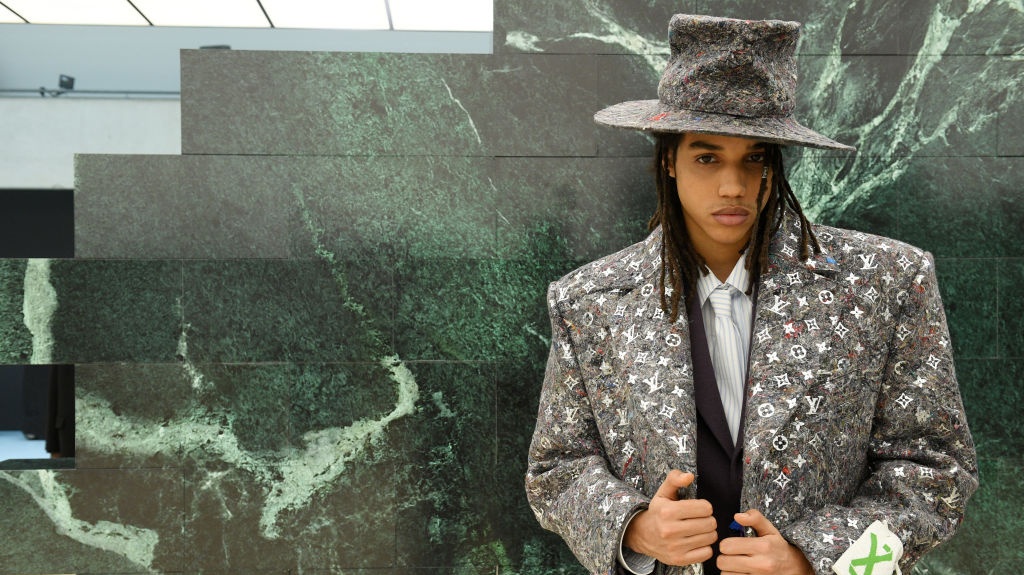If you’re interested in sharing your opinion on any cultural, political or personal topic, create an account here and check out our how-to post to learn more.
____
Set against Swiss snow and cold concrete Paris streets, Louis Vuitton's Men’s Fall-Winter 2021 Fashion Show began with American rapper and poet Saul Williams performing a poem mountainside, examining what it means to be Black in a white space. The poem paralleled Blackness in comparison to what fashion is allowed to be for Black bodies. Blackness is troupe often in fashion and needs to be contained rather than set free. Yet, Black bodies are made into spectacle and fanfare.
Thus, William's recital of the poem was haunting, exhilarating, thought-provoking and intersectional, to say the least. As the scene shifted from the mountain to a Paris terrain, the mood picked up alongside a diverse cast of models, emerging in well tailored suits and adorned with eclectic handbags and accessories.
It is important to situate that the show was thematically informed by James Baldwin's seminal 1953 essay entitled "Stranger in the Village." Abloh's choice to stage the show between the Swiss mountains and Paris was not ironic, but calculated like Baldwin, whose essay harkens to African-American visitors a Swiss village. Abloh and other Black creatives in fashion have experienced society's established structures of socio-cultural insiders and outsiders, especially within the fashion industry. Thus, while the cast was diverse and had many shades of skin tone, Louis Vuitton's Men's Creative Director, Virgil Abloh, placed a particular emphasis on showing the diversity of the Black male body.
It was hard to not get emotional looking at the collection. Each Black body that traversed the stage was accompanied by the name of a BIPOC person/deity from history to uplift the narrative and importance of the show being shown in the manner that it was. The models, many of which were Black, showed clothing seemingly from an era where access to luxury was not an option for the majority of Black people. Blackness has not always had a right to fashion, even though Blackness has been the metronome of what style is for centuries. This has especially ran true for the Black male body — cis, trans, nonbinary or otherwise. Furthermore, Abloh created clothing pieces that created structures literally such as cathedrals. In my opinion, this spoke to how Black bodies sometimes were not allowed in specific places, yet, could make them beautiful.
One particular scene from the show that epitomizes troupe of how Black male bodies have been used in fashion resides in the middle of the show. The scene begins with one Black model dancing in a drunkard state, seeming to be a metaphor for how Black men tend to aimlessly wander towards their goals because the world does not see them as anything else but a prop. This was contrasted by another Black model playing a flute as the former model continued to dance. This seemed to metaphorically stand for how Black men have the ability to be complex, yet, there is a constant duality taking place for Black men to simply exist. You can be creative but not outside of the bounds of whiteness and oppression.
This was cemented when Black trans poet and activist Kai-Isiah Jamal began reciting a poem penned for the show, which stated:
"You know when the girls used to take things for runaways or ballrooms. It is not stealing or robbing or looting. It is stepping into a fantasy that shouldn't be a utopia but just a living right. I think as Black people and as trans people and as marginalized people the world is here for our taking for it takes so much from us. I do know good thieves. Those who steal hearts and glittery dresses alike. Those who steal shows and gazes alike. Food for their baby and for their village. In fact, I know plenty of good thieves."
The poem was recited as a silver Louis Vuitton briefcase held by a dark skin Black man, which anchor's the show, sauntered by.
The use of the Black male body and art in Abloh's show speaks to how Black men should have, and should expect to have, more access to the fashion industry. However, that is not the case. Abloh's show, while gripping, is sadly still fantasy. Yet, his show is extremely important. It vies for the eyes of the beholder to critically interact with the landscape and bodies they are viewing. It asks them to think of Black male bodies as more than just stage pieces and stereotypes. It is a painfully beautiful exhibition to watch. Black men — cis, trans, nonbinary and other — should have the ability navigate the space of fashion boundlessly.
While the fashion industry still has much work to do, Abloh, creating a space for Black male bodies to be understood in a nuanced intersectional way, leads to possibilities for Black men and BIPOC persons who are often shied away from. We need more shows like this. Not only for Black men, but bodies not privilege to traverse a runaway naturally. It is hard work, but it is necessary. Hopefully, more creative directors and design houses will take note.
